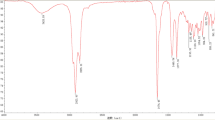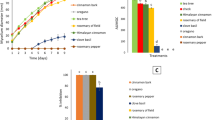Abstract
The use of fungicides in the postharvest treatment of mangoes has been widespread due to the incidence of pathogens, but awareness of the health risks arising from their use has increased, driving the search for more sustainable treatments. This study aimed to evaluate the activity of antifungal treatment of seven essential oils (EO) against four fungi that cause postharvest diseases in mangoes and define the minimum inhibitory concentration (MIC) and chemical composition, analyzed by gas chromatography (GC-MS). The results showed that the EOs of oregano, rosemary pepper, cinnamon bark, and clove inhibited 100% of the mycelial growth of the studied pathogens, with MIC ranging from 250 to 2000 μL.L−1. The main compound found in oregano was carvacrol (69.1%); in rosemary and pepper oil, it was thymol (77.2%); cinnamaldehyde (85.1%) was the main constituent of cinnamon bark, and the eugenol (84.84%) in cloves. When evaluating the antifungal activity of these compounds, thymol and carvacrol showed greater inhibitory activity against fungi. Therefore, this study showed the great potential of oregano, clove, rosemary pepper, and cinnamon bark essential oil as alternative treatments to synthetic fungicides in controlling postharvest diseases in mangoes.



Similar content being viewed by others

Explore related subjects
Discover the latest articles and news from researchers in related subjects, suggested using machine learning.Data availability
Data will be made available upon request.
References
Mirza B, Croley CR, Ahmad M, Pumarol J, Das N, Sethi G, Bishayee A (2021) Mango (Mangifera indica L.): a magnificent plant with cancer preventive and anticancer therapeutic potential. Crit Rev Food Sci Nutr 61:2125–2151. https://doi.org/10.1080/10408398.2020.1771678
Brazilian Horti & Fruit Yearbook (2022) Editora Gazeta. Disponível em: <https://www.editoragazeta.com.br/produto/anuario-brasileiro-de-horti-fruti-2022/>. Acesso em: 8 jan. 2023
Zhang Y, Gao Z, Hu M, Pan Y, Xu X, Zhang Z (2022) Delay of ripening and senescence in mango fruit by 6-benzylaminopurine is associated with inhibition of ethylene biosynthesis and membrane lipid catabolism. Postharvest Biol Technol 185:111797
da Costa Gonçalves D, Ribeiro WR, Goncalves DC, Menini L, Costa H (2021) Recent advances and future perspective of essential oils in control Colletotrichum spp.: a sustainable alternative in postharvest treatment of fruits. Food Res Int 150:110758. https://doi.org/10.1016/j.foodres.2021.110758
Zakaria L (2021) Diversity of Colletotrichum species associated with anthracnose disease in tropical fruit crops—a review. Agriculture 11:297. https://doi.org/10.3390/agriculture11040297
Benatar GV, Wibowo A, Suryanti (2021) First report of Colletotrichum asianum associated with mango fruit anthracnose in Indonesia. Crop Prot 141, 105432. https://doi.org/10.1016/j.cropro.2020.105432
Valenzuela-Ortiz G, Gaxiola-Camacho SM, San-Martín-Hernández C, Martínez-Téllez MÁ, Aispuro-Hernández E, Lizardi-Mendoza J, Quintana-Obregón E (2022) Chitosan sensitivity of fungi isolated from mango (Mangifera indica L.) with anthracnose. Molecules 27:1244. https://doi.org/10.3390/molecules27041244
Terao D, Batista DC, Ribeiro IJA (2016) Doenças da mangueira. In: Amorim L, Rezende JAM, Bergamin Filho A, Camargo LEA (eds) Manual de fitopatologia, vol 2, 5th edn. Agronômica Ceres Ltda, Ouro Fino, MG, pp 523–533
Xiaojiao L, Zeng S, Wisniewski M, Droby S, Yu L, An F, Leng Y, Wang C, Xiaojun L, He M, Liao Q, Liu J, Wang Y, Sui Y (2022) Current and future trends in the biocontrol of postharvest diseases. Crit Rev Food Sci Nutr 1–13. https://doi.org/10.1080/10408398.2022.2156977
Sánchez-Torres P (2021) Molecular mechanisms underlying fungicide resistance in citrus postharvest green mold. J Fungi 7:783. https://doi.org/10.3390/jof7090783
Kachur K, Suntres Z (2020) The antibacterial properties of phenolic isomers, carvacrol and thymol. Crit Rev Food Sci Nutr 60:3042–3053. https://doi.org/10.1080/10408398.2019.1675585
Dhifi W, Bellili S, Jazi S, Bahloul N, Mnif W (2016) Essential oils’ chemical characterization and investigation of some biological activities: a critical review. Medicines 3(4):25
He L-L, Zhao Y, Fan L-M, Zhan J-J, Tao L-H, Yang Y-H, Su F-W, Chen Q-B, Ye M (2023) In vitro and in vivo antifungal activity of Cymbopogon citratus essential oils from different climate conditions against Botrytis cinerea. Sci Hortic 308:111544. https://doi.org/10.1016/j.scienta.2022.111544
Di Francesco A, Aprea E, Gasperi F, Parenti A, Placì N, Rigosi F, Baraldi E (2022) Apple pathogens: organic essential oils as an alternative solution. Sci Hortic 300:111075. https://doi.org/10.1016/j.scienta.2022.111075
Cai X, Xu Z, Li X, Wang D, Ren X, Kong Q (2023) Underlying mechanism of menthol on controlling postharvest citrus sour rot caused by Geotrichum citri-aurantii. Postharvest Biol Technol 196:112160. https://doi.org/10.1016/j.postharvbio.2022.112160
Nandhavathy G, Dharini V, Anand Babu P, Nambiar RB, Periyar Selvam S, Sadiku ER, Mahesh Kumar M (2021) Determination of antifungal activities of essential oils incorporated-pomegranate peel fibers reinforced-polyvinyl alcohol biocomposite film against mango postharvest pathogens. Mater Today Proc 38:923–927. https://doi.org/10.1016/j.matpr.2020.05.384
Abbaszadeh S, Sharifzadeh A, Shokri H, Khosravi AR, Abbaszadeh A (2014) Antifungal efficacy of thymol, carvacrol, eugenol and menthol as alternative agents to control the growth of food-relevant fungi. J Mycol Médicale 24:e51–e56. https://doi.org/10.1016/j.mycmed.2014.01.063
Van de Vel E, Sampers I, Raes K (2019) A review on influencing factors on the minimum inhibitory concentration of essential oils. Crit Rev Food Sci Nutr 59:357–378. https://doi.org/10.1080/10408398.2017.1371112
Sarkhosh A, Schaffer B, Vargas AI, Palmateer AJ, Lopez P, Soleymani A (2018) In vitro evaluation of eight plant essential oils for controlling Colletotrichum, Botryosphaeria, Fusarium and Phytophthora fruit rots of avocado, mango and papaya. Plant Prot Sci 54(3):153–162
Adams RP (2009) In identification of essential oil components by gas chromatography/quadrupole mass spectroscopy, 4th edn. Allured Publishing Corporation, Carol Stream
Santos SN, Melo I (2016) A rapid primary screening method for antitumor using the oomycete Pythium aphanidermatum. Nat Prod Chem Res 4:4–7
Campbell CL, Madden LV (1990) Introduction to plant disease epidemiology. John Wiley & Sons, New York
Yan J, Wu H, Chen K, Feng J, Zhang Y (2021) Antifungal activities and mode of action of Cymbopogon citratus, Thymus vulgaris, and Origanum heracleoticum essential oil vapors against Botrytis cinerea and their potential application to control postharvest strawberry gray mold. Foods 10:2451. https://doi.org/10.3390/foods10102451
Almasaudi NM, Al-Qurashi AD, Elsayed MI, Abo-Elyousr KAM (2022) Essential oils of oregano and cinnamon as an alternative method for control of gray mold disease of table grapes caused by Botrytis cinerea. J Plant Pathol 104:317–328. https://doi.org/10.1007/s42161-021-01008-8
Regnier T, Combrinck S, Veldman W, Du Plooy W (2014) Application of essential oils as multi-target fungicides for the control of Geotrichum citri-aurantii and other postharvest pathogens of citrus. Ind Crop Prod 61:151–159. https://doi.org/10.1016/j.indcrop.2014.05.052
Andrade-Ochoa S, Chacón-Vargas KF, Sánchez-Torres LE, Rivera-Chavira BE, Nogueda-Torres B, Nevárez-Moorillón GV (2021) Diferencial antimicrobial effect of essential oils and their main components: insights based on the cell membrane and external structure. Membranes 11:405. https://doi.org/10.3390/membranes11060405
Oliveira J, Gloria EM, Parisi MCM, Baggio JS, Silva PPM, Ambrosio CMS, Spoto MHF (2019a) Antifungal activity of essential oils associated with carboxymethylcellulose against Colletotrichum acutatum in strawberries. Sci Hortic 243:261–267. https://doi.org/10.1016/j.scienta.2018.08.032
Oliveira J, Parisi MCM, Baggio JS, Silva PPM, Paviani B, Spoto MHF, Gloria EM (2019b) Control of Rhizopus stolonifer in strawberries by the combination of essential oil with carboxymethylcellulose. Int J Food Microbiol 292:150–158. https://doi.org/10.1016/j.ijfoodmicro.2018.12.014
Haddout S (2022) Different essential oil on antifungal activity of grape Fusarium sp. In: Advances in Food Safety and Environmental Engineering, 1st edn. CRC Press, London. https://doi.org/10.1201/9781003318514-12
Vilaplana R, Pazmiño L, Valencia-Chamorro S (2018) Control of anthracnose, caused by Colletotrichum musae, on postharvest organic banana by thyme oil. Postharvest Biol Technol 138:56–63. https://doi.org/10.1016/j.postharvbio.2017.12.008
Danh LT, Giao BT, Duong CT, Nga NTT, Tien DTK, Tuan NT, Huong BTC, Nhan TC, Trang DTX (2021) Use of essential oils for the control of anthracnose disease caused by Colletotrichum acutatum on post-harvest mangoes of Cat Hoa Loc variety. Membranes 11:719. https://doi.org/10.3390/membranes11090719
Nunes CR, Valente PM, Silva FD da, Valente VMM (2021) Composição química e atividade antifúngica do óleo essencial de thymus vulgaris sobre Aspergillus niger, Penicillium expansum, Sclerotinia sclerotiorum e Sclerotium rolfsii. Braz J Dev 7, 14250–14260. https://doi.org/10.34117/bjdv7n2-173
Sivaram S, Somanathan H, Kumaresan SM, Muthuraman MS (2022) The beneficial role of plant based thymol in food packaging application: a comprehensive review. Appl Food Res 2:100214. https://doi.org/10.1016/j.afres.2022.100214
Zhang J, Ma S, Du S, Chen S, Sun H (2019) Antifungal activity of thymol and carvacrol against postharvest pathogens Botrytis cinerea. J Food Sci Technol 56:2611–2620. https://doi.org/10.1007/s13197-019-03747-0
Milagres de Almeida J, Crippa BL, Alencar M, de Souza VV, Perez Alonso VP, da Motta Santos Júnior E, Siqueira Franco Picone C, Prata AS, Cirone Silva NC (2023) Antimicrobial action of oregano, thyme, clove, cinnamon and black pepper essential oils free and encapsulated against foodborne pathogens. Food Control 144:109356. https://doi.org/10.1016/j.foodcont.2022.109356
Spadaro D, Gullino ML (2014) Use of essential oils to control postharvest rots on pome and stone fruit. In: Prusky D, Gullino ML (eds) Post-Harvest Pathology. Springer International Publishing, Cham, pp 101–110. https://doi.org/10.1007/978-3-319-07701-7_9
Souza VVMA, Almeida JM, Barbosa LN, Silva NCC (2022) Citral, carvacrol, eugenol and thymol: antimicrobial activity and its application in food. J Essent Oil Res 34:181–194. https://doi.org/10.1080/10412905.2022.2032422
Acknowledgements
The authors thank the São Paulo Research Foundation (Fundação de Amparo à Pesquisa do Estado de São Paulo - FAPESP: 2018/25318-7) for the financial support. The authors also thank Mrs. Rosely dos Santos Nascimento and Miss Débora Renata Cassoli de Souza for their help in carrying out the experiments.
Author information
Authors and Affiliations
Corresponding author
Ethics declarations
Conflict of interest
The authors declare no competing interests.
Additional information
Publisher’s Note
Springer Nature remains neutral with regard to jurisdictional claims in published maps and institutional affiliations.
Responsible Editor: Admir Giachini
Rights and permissions
Springer Nature or its licensor (e.g. a society or other partner) holds exclusive rights to this article under a publishing agreement with the author(s) or other rightsholder(s); author self-archiving of the accepted manuscript version of this article is solely governed by the terms of such publishing agreement and applicable law.
About this article
Cite this article
Vilela, E.S.D., Terao, D., do Nascimento de Queiroz, S.C. et al. Essential oils on the control of fungi causing postharvest diseases in mango. Braz J Microbiol 55, 689–698 (2024). https://doi.org/10.1007/s42770-023-01237-2
Received:
Accepted:
Published:
Issue Date:
DOI: https://doi.org/10.1007/s42770-023-01237-2
Keywords
Profiles
- Elke Simoni Dias Vilela View author profile



